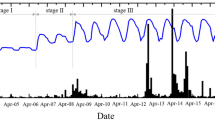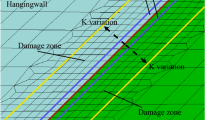Abstract
Reservoir induced seismicity provides a suitable method for studying the roles of fluid in inducing earthquakes. The fault structure plays a predominant role in the occurrences of earthquakes, and the influences of fluid also cannot be disregarded. In this study, we investigate the active Fairy Mount fault in the Three Gorges Reservoir. Since water impoundment in 2003, more than 4000 detectable earthquakes have occurred along the fault. The vast majority of these earthquakes are associated with the fault and water impoundment. To explore the effects of water-fault interactions on induced earthquakes, a permeability structure of the fault zone is established by a series of geological experiments. Fault rocks, including unconsolidated breccias and fault gouges, collected from a presentative outcrop are employed for detailed microstructural and mineralogical analyses. The results reveal a complex internal fault structure and widespread fluid-rock interactions. The hydrogeological property of the fault exhibits a typical conduit/barrier permeability structure. Highly permeable damage zones act as fluid conduits for the infiltration of reservoir water to the subsurface, while the low permeable fault core renders the fault core as a potential fluids storage area to weaken the fault in the shallow crust. In sum, both the pore pressure changes due to water infiltration and the long-term chemical effect of water on the fault plane promote instability of the fault and induce earthquakes.









Similar content being viewed by others
References
Alt RC, Zoback MD (2017) In situ stress and active faulting in Oklahoma. Bull Seismol Soc Am 107(1):216–228
Bense VF, Gleeson T, Loveless SE, Bour O, Scibek J (2013) Fault zone hydrogeology. Earth-Sci Rev 127:171–192
Billi A, Salvini F, Storti F (2003) The damage zone-fault core transition in carbonate rocks: implications for fault growth, structure and permeability. J Struct Geol 25(11):1779–1794
Caine JS, Evans JP, Forster CB (1996) Fault zone architecture and permeability structure. Geology 24(11):1025–1028
Chen LY, Talwani P (1998) Reservoir-induced sesimicity in China. Pure Appl Geophys 153(1):133–149
Chen SJ, Su AJ, Luo DG (2004) Genesis and type of induced earthquake in Three Gorges reservoir. J Geod Geodyn 2:70–74
Chen R (2009) Did the reservoir impoundment trigger the Wenchuan earthquake? Sci China Ser D-Earth Sci 52:431–433
Chen JY, Yang XS, Ma SL, Spiers CJ (2013) Mass removal and clay mineral dehydration/rehydration in carbonate-rich surface outcrops of the 2008 Wenchuan Earthquake fault: geochemical evidence and implications for fault zone evolution and coseismic slip. J Geophys Res Solid Earth 118:474–496
Duan Q, Yang X, Chen J (2017) Hydraulic properties of a low permeable rupture zone on the Yingxiu-Beichuan Fault activated during the Wenchuan earthquake, China: Implications for fluid conduction, fault sealing, and dynamic weakening mechanisms. Tectonophysics 721:123–142
El Hariri M, Abercrombie RA, Rowe CA, do Nascimento AF (2010) The role of fluids in triggering earthquakes: observations from reservoir induced seismicity in Brazil. Geophys J Int 181(3):1566–1574
Ellsworth WE (2013) Injection-induced earthquakes. Science 341(6142):1225942
Evans JP, Forster CB, Goddard JV (1997) Permeabilities of fault-related rocks and implications for fault-zone hydraulic structure. J Struct Geol 19(11):1393–1404
Faulkner D, Jackson C, Lunn R, Schlische R, Shipton Z, Wibberley C, Withjack M (2010) A review of recent developments concerning the structure, mechanics and fluid flow properties of fault zones. J Struct Geol 32:1557–1575
Folk RL (1951) A comparison chart for visual percentage estimation. J Sediment Petrol 21(1):32–33
Gahalaut K, Hassoup A (2012) Role of fluids in the earthquake occurrence around Aswan reservoir, Egypt. J Geophys Res 117:B02303
Ganerod GV, Braathen A, Willemoeswissing B (2008) Predictive permeability model of extensional faults in crystalline and metamorphic rocks; verification by pre-grouting in two sub-sea tunnels, Norway. J Struct Geol 30(8):993–1004
Gillian RF, Miles W, Gluyas J, Bruce RJ, Richard D (2018) Global review of human-induced earthquakes. Earth-Sci Rev 178:438–514
Goddard JV, Evans JP (1995) Chemical changes and fluid-rock interaction in faults of crystalline thrust sheets, northwestern Wyoming, USA. J Struct Geol 17:533–547
Gough DI, Gough WI (1970) Stress and deflection in the lithosphere near Lake Kariba. Geophys J Int 21:65–78
Grigoli F, Cesca S, Priolo E, Rinaldi AP, Clinton JF, Stabile TA, Dost B, Fernandez MG, Wiemer S, Dahm T (2017) Current challenges in monitoring, discrimination, and management of induced seismicity related to underground industrial activities: a European perspective. Rev Geophys 55(2):310–340
Gupta HK, Rastogi BK (1976) Dams and Earthquakes. Elsevier, Amsterdam, pp 1–229
Gupta HK (2002) A review of recent studies of triggered earthquakes by artificial water reservoirs with special emphasis on earthquakes in Koyna, India. Earth-Sci Rev 58(3/4):279–310
Hua W, Zheng SH, Yan CQ, Chen ZL (2013) Attenuation, site effects, and source parameters in the Three Gorges reservoir area, China. Bull Seismol Soc Am 103:371–382
Jiang HK, Song J, Wu Q (2012) Quantitative investigation of fluid triggering on seismicity in the Three Gorges reservoir area based on ETAS model. Chinese J Geophys 55(7):2341–2352 (in Chinese)
Kundu B, Vissa NK, Gahalaut VK (2015) Influence of anthropogenic groundwater unloading in Indo-Gangetic plains on the 25 April 2015 Mw 7.8 Gorkha, Nepal earthquake. Geophys Res Lett 42:10607–10613
Lawther SE, Dempster TJ, Shipton ZK, Boyce AJ (2016) Effective crustal permeability controls fault evolution: an integrated structural, mineralogical and isotopic study in granitic gneiss, Monte Rosa, northern Italy. Tectonophysics 690:160–173
Lei XL, Yu G, Ma S, Wen X, Wang Q (2008) Earthquakes induced by water injection at ~3 km depth within the Rongchang gasfield, Chongqing, China. J Geophys Res 113:B10310
Lei X, Tamagawa T, Tezuka K, Takahashi M (2011) Role of drainage conditions in deformation and fracture of porous rocks under triaxial compression in the laboratory. Geophys Res Lett 38(24):L24310
Lei X, Ma S, Chen W, Pang C, Zeng J, Jiang B (2013) A detailed view of the injection-induced seismicity in a natural gas reservoir in Zigong, southwestern Sichuan Basin, China. J Geophys Res 118(8):4296–4311
Li Q, Zhao X, Cai JA, Liu RF, Long GH, AN YR (2009) P wave velocity structure of upper crust in Three Gorges Reservoir region of the Yangtze River. Sci China Ser D-Earth Sci 39(4):427–436
Liu YW, Xu LQ, Yang DX (2011) Pore pressure diffusion characteristics of Longtan reservoir-induced-earthquake. Chin J Geophys 54(4):1028–1037 (in Chinese)
Luo JH, Ma HT (2016) A preliminary study on upper crustal velocity structure in the Three Gorges reservoir area. Seismology and Geology 38(2):329–334 (in Chinese)
Masuda K, Nishizawa O, Kusunose K, Satoh T, Takahashi M (1990) Positive feedback fracture process induced by nonuniform high-pressure water flow in dilatant granite. J Geophys Res 95(B13):21583–21592
Ming X, Liu L, Yu M, Bai H, Yu L, Peng X, Yang T (2016) Bleached mudstone, iron concretions and calcite veins: A natural analogue for the effects of reducing CO2-bearing fluids on iron migration and mineralization, sealing properties and composition of mudstone cap rocks. Geofluids 16(5):1017–1042
Morrow C, Shi LQ, Byerlee J (1981) Permeability and strength of San Andreas fault gouge under high pressure. Geophys Res Lett 8(4):325–328
Nascimento AF, Lunn RJ, Cowie PA (2004) Numerical modelling of pore-pressure diffusion in a reservoir-induced seismicity site in northeast Brazil. Geophys J Int 160(1):249–262
Nur A, Booker JR (1972) Aftershocks caused by pore fluid flow? Science 175:885–887
Roeloffs E (1988) Fault stability changes induced beneath a reservoir with cyclic variations in water level. J Geophys Res 93:2107–2124
Schloz CH, Sykes LR, Aggarwl YP (1973) Earthquake prediction: A physical basis. Science 181:803–810
Sibson RH (1977) Fault rocks and fault mechanisms. J Geol Soc 133:191–213
Talwani P, Acree S (1985) Pore Pressure Diffusion and the Mechanism of Reservoir-induced Seismicity. Pure Appl Geophys 122:947–965
Tao W, Masterlark T, Shen Z, Ronchin E (2015) Impoundment of the Zipingpu reservoir and triggering of the 2008 Mw 7.9 Wenchuan earthquake, China. J Geophys Res 120(10):7033–7047
Whitney DL, Evans BW (2010) Abbreviations for names of rock-forming minerals. Am Mineral 95:185–187
Wibberley CA, Shimamoto T (2002) Internal structure and permeability of major strike-slip fault zones: the Median Tectonic Line in Mie Prefecture, Southwest Japan. J Struct Geol 25:59–78
Yao YS, Wang QL, Liao WL, Zhang LF, Chen JH, Li JG, Yuan L, Zhao YN (2017) Influences of the Three Gorges project on seismic activities in the reservoir area. Sci Bull 62:1089–1098
Yi LX, D Z, CL L (2012) Preliminary study of reservoir-induced seismicity in the Three Gorges reservoir, China. Seismol Res Lett 83(5):806–814
Zhang LF, Li JG, Sun XD, Liao WL, Zhao YN, Wei GC, He CF (2018) A possible mechanism of reservoir-induced earthquakes in the Three Gorges Reservoir, central China. Bull Seismol Soc Am 108(5B):3016–3028
Zhang LF, Lei XL, Liao WL, Li JG, Yao YS (2019) Statistical parameters of seismicity induced by the impoundment of the Three Gorges Reservoir, Central China. Tectonophysics 751:13–22
Zhou B, Xue SF, Deng ZH, Sun F, Jiang HK (2010) Relationship between the evolution of reservoir-induced seismicity in space-time and the process of reservoir water body load-unloading and water infiltration—a case study of Zipingpu reservoir. Chin J Geophys 53(11):2651–2670
Zhou LQ, Zhao CP, Luo J, Chen ZL (2018) A detailed insight into fluid infiltration in the Three Gorges reservoir Area, China, from 3DVP, VP/VS, QP and QS Tomography. Bull Seismol Soc Am 108(5B):3029–3045
Acknowledgements
We would like to thank editor and the anonymous reviewers for the improvement of the article. We also would like to thank Prof. Yongsheng Zhou, Prof. Jing He, Dr. Yann Zhao and Dr. Yueqiang Qiao for their good suggestion. This work was financially supported by National Natural Science Foundation of China (41772384,41572354), Science for Earthquake Resilience (XH19030) and Scientific Research Fund of Institute of Seismology and Institute of Crustal dynamics, China Earthquake Administration (IS201616254).
Author information
Authors and Affiliations
Corresponding author
Additional information
Editorial handling: M.A.T.M. Broekmans
Publisher’s note
Springer Nature remains neutral with regard to jurisdictional claims in published maps and institutional affiliations.
Rights and permissions
About this article
Cite this article
Zhang, L., Liao, W., Yao, Y. et al. Effect of interaction between fluid and fault zone on triggering earthquakes in the shallow crust. Miner Petrol 113, 493–504 (2019). https://doi.org/10.1007/s00710-019-00665-z
Received:
Accepted:
Published:
Issue Date:
DOI: https://doi.org/10.1007/s00710-019-00665-z




